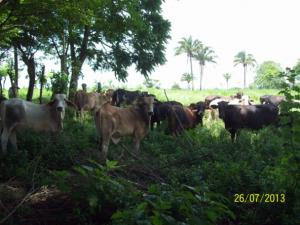Mexico is the third-largest market for U.S. distiller’s dried grains with solubles (DDGS) but its southern region is remains an underserved livestock sector growth potential for U.S. exports. The U.S. Grains Council is on the precipice of opening this market for U.S. grain exporters.
In 2012, the Council conducted an assessment of southern Mexico’s potential to begin using DDGS to feed livestock.
Positive results of this pilot program could bode well for expansion; in 2013, Mexico imported 1.3 million metric tons for feeding purposes. The potential exists to more than double current amounts by providing technical and practical education to local cattlemen.
“Livestock production in this area can be characterized as small-scale producers with limited access to imported grain feeds,” said Julio Hernandez, USGC director in Mexico. “Our assessment showed despite limited investment in this area by importers and feed millers, the region had tremendous import potential for feed grains, ranging from 1.5 to 3 million tons per year.”
The Council began exploring opportunities to promote the use of U.S. DDGS to ruminant producers in the area. A trial was conducted over a 100-day period in which grazing cattle received a supplemental ration of 1kg (2.2 pounds) of feed concentrate (80 percent DDGS) per animal per day.
The results were dramatic and encouraging. Supplemented cattle grew twice as fast as the control group. This demonstrated cattle supplemented with feed concentrate using DDGS reduced the time it took to reach market weight in half, from 200 to 100 days. Southern Mexico’s cattlemen would benefit despite the additional cost of purchasing the feed concentrate, potentially doubling profits.
As result of these promising initial trials, a local cattleman who leads a nearby consortium of cattle farmers committed to conducting further commercial trials with more than 30,000 head of cattle.
“The Council’s Mexico office will work closely with this group to ensure understanding and success,” Hernandez said. “We are already working with regional importers to develop a smooth flow of DDGS to the region.”
Results of the forthcoming trials will be disseminated in the region – including Quintana Roo, Campeche, Tabasco and Chiapas – illustrating to cattlemen that they can enhance their income through use of U.S. DDGS in feed concentrates. These areas comprise a large amount of beef, dairy, dual-purpose cattle and swine herds with little to no exposure to DDGS.
“This region has tremendous growth potential for U.S. DDGS and could eventually achieve a demand of more than 1 million tons per year,” said Javier Chavez, USGC marketing specialist in Mexico. “An increased demand will generate interest from suppliers and expanding DDGS availability at competitive prices is inevitable.”


